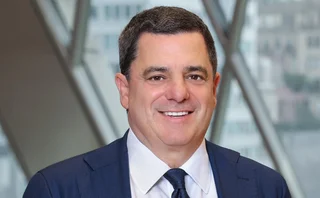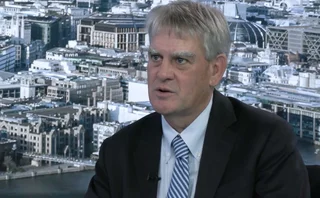
Interest rate derivatives house of the year: Bank of America
Risk Awards 2022: Bank ducks US vol problems that plagued peers, while continuing European expansion

On Saturday, February 20, 2021, Michael Stanley, co-head of global rates and counterparty portfolio management at Bank of America (BofA), was on a New York bus on his way to return his children’s library books when a phone call with his co-head, Kavi Gupta, alerted him to something remarkable.
The bank’s proprietary early volatility warning system, Glass (nicknamed ‘Norad’, after the North American air defence system), was throwing out some marked early signs of fragility in US vol, against all expectations.
“I called Kavi, and he said: ‘Do you see what Norad is seeing?’ It was truly dramatic,” says Stanley.
At the time, the consensus was that US Federal Reserve rate moves were on hold until 2024, so front-end rates vol was low – and realised vol was even lower – which meant macro investors were typically short front-end vol.
But Glass was detecting that front-end rates, and vols, were on the move – only by a few basis points, but it triggered further analysis by the team. Because the minimum increment for a Fed hike is 25bp, the front end of the curve vol had the potential to move higher very fast.
The team quickly decided they needed their books to be flat or long volatility ahead of any potential move.
It was the right call. As the stimulus plans led to expectations that rate hikes could come sooner rather than later, front-end vol began moving up along with rates. But a number of other dealers were caught out, and were left nursing losses.
Having relatively clean books allowed the bank to be more confident in calling the top, buying vol from clients such as systematic funds, when levels were extremely elevated in March, and selling to other clients looking to fade the move.
Stanley recognises the escape that Glass permitted: “I think the US vol business did very well in the first quarter, avoiding some of the big landmines that I think our competitors got caught up in.”
In case of emergency, break Glass
In the few years up to that point, Bank of America’s rates volatility team had been noticing a strange phenomenon in the US vol market. It was becoming increasingly fragile and more prone to big, sudden moves – which makes for a dangerous environment on a swaptions desk.
In an effort to get a greater understanding of what was happening, the team decided to build a tool that would give an early warning of such an event. It would aggregate market data across all the US linear flow rates instruments it trades – from outright prices of Eurodollar futures to the bases between over-the-counter and exchange-traded products – into one interface with graphs, Z-scores and other easy-to-digest information.
The tool – which would become Glass – would allow the team to quickly see when telltale divergences were occurring that could have knock-on effects on the swaptions markets. And, in turn, decide if and when to adjust their activity in the market to avoid getting caught on the wrong side of a sudden vol move.
I think the US vol business did very well in the first quarter, avoiding some of the big landmines that I think our competitors got caught up in
Michael Stanley, Bank of America

When the February klaxon to a possible rate hike went off, Glass hadn’t been in action for long, having been deployed at the start of the year.
Against the dovish rates outlook at that point, president Joe Biden’s stimulus bills had started getting the market thinking about inflation and its potential impact on rates.
“There was a lot of cash going into the system. And there were prominent voices at the time who were saying it’s enough cash to drive an inflation story [that] perhaps from there would drive a Fed hiking cycle,” says Stanley.
The event acted as a kind of calibration for Glass. The tool again warned of a similar, though less dramatic, rates vol market move in September, which allowed the bank again to position itself accordingly.
And while Bank of America’s rates vol team navigated a volatile market that wrong-footed others, the linear business went from strength to strength – it recorded a 500bp improvement in its vanilla US dollar swaps market share in the first half of the year.
On Bloomberg, the bank sits in the top three by DV01 – the sensitivity of trades to a 1bp move in the underlying interest rates – for the full year 2021.
Part of this is driven by the bank’s strong US Treasury trading franchise – with the US swaps market generally priced at a spread over the government bond curve, this helps with accurate pricing. BofA had more than a 20% market share, for example, in the 11-years-and-above sector of the US Treasuries curve for the full year 2021, according to data from the Fed– including an estimated share of around 30% at the illiquid 20-year point.
Gupta says another key differentiator for the rates business this past year was the bank’s work around the Libor transition. It was early in providing identical pricing for secured overnight financing rate (SOFR) swaps and Libor swaps, where others had higher SOFR pricing due to the lower liquidity at the time.
But BofA’s client franchise is extremely broad, bringing in a number of corporate and commercial counterparties – not all of which want to use SOFR for their lending, debt issuance or hedging.
One alternative benchmark is the Bloomberg Short-Term Bank Yield (BSBY) Index, which includes credit sensitivity like the outgoing Libor rate. Despite negative comments from some US regulators, the benchmark has seen some interest from borrowers looking for an alternative to SOFR.

Bank of America was a counterparty to the first BSBY swap in May 2021, and the bank has been one of the few dealers willing to enter swaps against the benchmark to allow clients to hedge those loans.
Trading against multiple benchmarks means there is more basis risk to manage. To help tackle this, the bank combined its short-term rates desk – which traditionally handles basis trading – with its medium-term swaps trading desk globally, giving the business a unified view on how to price its various products.
“It’s important to understand all these various basis risks, just given the number of indices out there, and being able to price that,” says Gupta.
“It used to be that you’d have to go to two traders to get a price. Now, you go to one trader and get one price, so it’s seamless between the two desks. We’ve aligned the reporting lines, as well. That’s been a big win for us – because, frankly, just trading three-month Libor is not really a business any more – you really have to be able to trade the index the customer wants.”
Hands across the pond
In Europe, BofA has been expanding its reach into the continent from its Paris office, which it opened in 2019, and has been steadily making new appointments.
It has made a particular effort to win primary dealer roles for government bond issuances across the region, including Italy, Germany, France and the UK – adding Portugal and the Netherlands in 2021. It has also had a role in two lots of issuance from the European Union so far, including its inaugural 2036 green bond.
Snigdha Singh, co-head of fixed income, currencies and commodities trading for Europe, the Middle East and Africa (EMEA), and head of EMEA rates trading at BofA, says a strong position in the various sovereign bond markets in Europe is crucial to be able to fully service rates clients in the region.
Not only does it make the bank’s own hedging easier, but it puts the bank in a better position to offer European clients their choice of instrument.
“A lot of the business even on the derivatives side may have an asset swap leg, or it may be a choice in terms of hedging in cash or hedging in derivatives, depending on things like levels or cross-market yields,” says Singh.
In swaps, Bank of America has managed to grab a roughly 40% share of inquiries for euro and sterling on Bloomberg for the full year 2021, which Singh says translates into a traded market share of somewhere between 10% and 11% for the two currencies.
Clients have noticed the growth in BofA’s euro swaps business. “Five years ago, they were not as strong as they are now,” says a portfolio manager at one European asset manager. “They hired a lot of people in trading and sales of the highest quality. And that’s why they are coming up now – from zero to hero.”
A trader at a second European asset manager praises the quality of the firm’s rates research: “It’s very personal service. Analysts actually contact me personally – they come to me and say: ‘I noticed in the past you wanted to know X – let’s talk about it. Given the moves we’ve seen, is there anything you have questions on?’ I don’t know where they find time, but they’re very, very good.”
Cross-currency swaps were a big focus for the bank this year, and one of its biggest trades of the year globally saw it acting as sole hedge co-ordinator for a European corporate looking to hedge a jumbo US dollar bond offering. The hedge consisted of a series of trades from five to 30 years in maturity, totalling more than $2 billion in notional, and taking the client from US dollars back to euros.
In the sterling swaps market, one large real money client says that, while risk capacity has been down across the market, BofA was one of the few that consistently stepped up and was able to get trades done when required.
The bank was also heavily involved with transitioning corporate sterling Libor swap users onto the replacement Sonia before it ceased at the end of 2021. One highlight in the second quarter of 2021 saw it act as sole hedge co-ordinator for the transition of a £500 million ($679 million) portfolio of Libor swaps across multiple tenors – from five up to 19 years – onto Sonia.
The corporate’s Libor swap portfolio was spread across multiple dealers. As hedge co-ordinator, BofA traded Sonia-Libor basis swaps with the corporate against the net basis risk it had against all the banks. Bank of America then novated these basis swaps to each of the dealers, which enabled these banks to convert the corporate’s swaps into Sonia.
Elsewhere, over the past few years, BofA has made moves to boost its quantitative investment strategies (QIS) offering in the rates space. After the QIS sector saw big drawdowns in assets under management across the Street during 2020, as Covid-19 saw firms retreat back to basics, BofA saw an opportunity to build out defensive strategies based on OTC rates volatility instruments.
It launched the resulting indexes – named Raven –at the start of 2021. In one highlight of the first quarter, the bank worked with a European asset manager on a $750 million mandate to provide a defensive overlay for a fund that had a 60:40 split of shares and bonds.
The 60:40 strategy has been under strain in a world where low rates have tested fixed income’s usefulness as an equity hedge, so BofA suggested a US volatility-based QIS strategy to provide a macro hedge over the top.
“The 60:40 is broken, and this is how you plug the gap,” says Paul Connaughton, head of global QIS trading at BofA. “Effectively, bonds don’t have the convexity that they used to, but if you add a layer of long rates vol, that brings the convexity back –so you can patch up a 60:40 portfolio and make it work like it should.”
“That was a very appealing pitch to this particular investor, and they rotated out of a lot of equity-specific hedges and allocated three-quarters of a billion of AUM to our defensive framework,” he adds.
The trade went live in the first quarter, just ahead of the bout of US rates volatility.
Heeding the vol alarm – the sound of breaking Glass – has worked well for BofA.
Only users who have a paid subscription or are part of a corporate subscription are able to print or copy content.
To access these options, along with all other subscription benefits, please contact info@risk.net or view our subscription options here: http://subscriptions.risk.net/subscribe
You are currently unable to print this content. Please contact info@risk.net to find out more.
You are currently unable to copy this content. Please contact info@risk.net to find out more.
Copyright Infopro Digital Limited. All rights reserved.
As outlined in our terms and conditions, https://www.infopro-digital.com/terms-and-conditions/subscriptions/ (point 2.4), printing is limited to a single copy.
If you would like to purchase additional rights please email info@risk.net
Copyright Infopro Digital Limited. All rights reserved.
You may share this content using our article tools. As outlined in our terms and conditions, https://www.infopro-digital.com/terms-and-conditions/subscriptions/ (clause 2.4), an Authorised User may only make one copy of the materials for their own personal use. You must also comply with the restrictions in clause 2.5.
If you would like to purchase additional rights please email info@risk.net
More on Awards
Collateral management and optimisation product of the year: CloudMargin
Delivering the modern blueprint for enterprise collateral resilience
Flow market-maker of the year: Citadel Securities
Risk Awards 2026: No financing; no long-dated swaps? “No distractions,” says Esposito
Pricing and analytics: fixed income – Quantifi
Quantifi delivers high-performance, transparent and adaptable pricing and risk analytics for fixed income and credit markets
Derivatives house of the year: Citi
Risk Awards 2026: Rev up, RWAs down, as US bank gets back on track (with added XiNG and XiP)
Technology vendor of the year: SS&C Algorithmics
Risk Awards 2026: From cloud, to chips, to maths tricks – vendor getting more out of existing tech
SS&C Algorithmics: winner’s interview with Curt Burmeister
SS&C Algorithmics wins three categories in this year’s Markets Technology Awards in addition to Technology vendor of the year at the Risk Awards
Best vendor for system support and implementation: Murex
Murex wins Best vendor for system support and implementation at the Markets Technology Awards 2026
Pricing and analytics: cross-asset and structured – Murex
Murex wins Pricing and analytics: cross-asset and structured at the Markets Technology Awards 2026 thanks to its MX.3 platform







